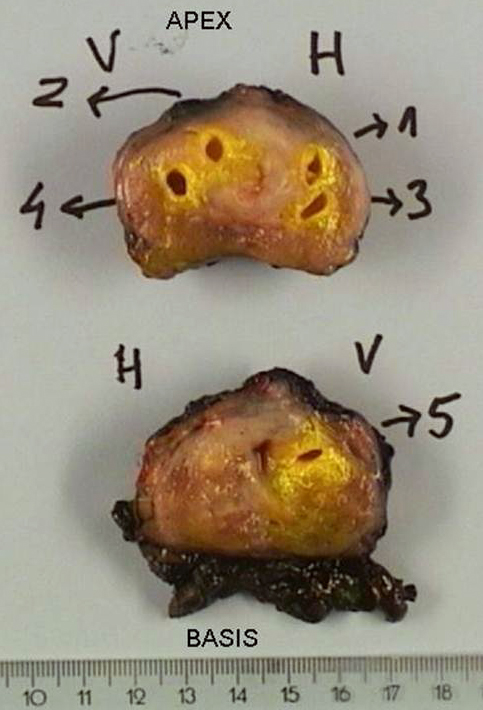Research biobank with multisampled primary prostate cancer
Several past and ongoing research projects utilise a biobank containing multiple frozen tissue cores from primary prostate cancer. With as many as three quarters of prostate cancers being multifocal, this biobank facilitates the study of interfocal heterogeneity regarding gene mutations and expression, including fusion gene characterisation.

The biobank comprises tissue samples obtained from a cohort of 571 patients who underwent surgery at Oslo University Hospital-Radiumhospitalet between 2010 and 2012, having granted informed consent to participate in the study. The sampling protocol was established by Researchers at Departments of Pathology (led by A. Kathrine Lie, now followed-up by Ulrika Axcrona), Molecular Oncology (led by Ragnhild A. Lothe, now followed-up by Rolf Skotheim), and Urology (Karol Axcrona).
The sampling protocol was inspired by visits to the MD Anderson Cancer Centre and Memorial Sloan Kettering Cancer Centre. After prostatectomy, the specimen is transported on ice, weighed, orientated, and marked. A cross-section through the prostate is guided by palpation and results from MR and biopsies taken prior to surgery. Three to eight tissue cores are biobanked (frozen) from each prostatectomy, with diameter of 6 mm. The holes are marked and the sections and orientation photographed. The two halves of the prostate are pinned to a cork plate and fixed in formalin for at least 48 hours.
From each patient and specimen, we have detailed histopathological evaluation, with DNA and RNA isolated. The quality of the material is exceptionally good, as illustrated by the more than 1000 RNA-integrity (RIN) values with an average RIN of 9.7.
Several research projects utilize the biobank, and there is an accumulating amount of omics and other molecular data associated with it.
Selected publications
Bogaard M, Skotheim RI, Maltau AV, Kidd SG, Lothe RA, Axcrona K*, and Axcrona U* (2023). 'High proliferative cribriform prostate cancer' defines a patient subgroup with an inferior prognosis. Histopathology (online ahead of print) *Shared senior authors
Carm KT, Johannessen B, Bogaard M, Bakken AC, Maltau AMV, Hoff AM, Axcrona U, Axcrona K, Lothe RA, and Skotheim RI (2023). Somatic mutations reveal complex metastatic seeding from multifocal primary prostate cancer. Int. J. Cancer 152(5): 945-51
Kidd SG*, Bogaard M*, Carm KT, Bakken AC, Maltau AMV, Løvf M, Lothe RA, Axcrona K, Axcrona U**, and Skotheim RI** (2022). In situ expression of ERG protein in the context of tumor heterogeneity identifies prostate cancer patients with inferior prognosis. Mol. Oncol. 16(15): 2810-22 Shared *first/**senior authors
Strømme JM, Johannessen B, Kidd SG, Bogaard M, Carm KT, Zhang X, Sveen A, Mathelier A, Lothe RA, Axcrona U, Axcrona K, and Skotheim RI (2022). Expressed prognostic biomarkers for primary prostate cancer independent of multifocality and transcriptome heterogeneity. Cancer Gene Therapy 29(8-9): 1276-84
Kidd SG*, Carm KT*, Bogaard M, Olsen LG, Bakken AC, Løvf M, Lothe RA, Axcrona K, Axcrona U, and Skotheim RI (2021). High expression of SChLAP1 in primary prostate cancer is an independent predictor of biochemical recurrence, despite substantial heterogeneity. Neoplasia 23(6): 634-641 *Equal contribution
Carm KT, Hoff AM, Bakken AC, Axcrona U, Axcrona K, Lothe RA, Skotheim RI*, and Løvf M (2019). The clinical usefulness of molecular classification of primary prostate cancer is challenged by interfocal heterogeneity. Scientific Reports 9: 13579 *Corresponding author
Løvf M, Zhao S, Axcrona U, Johannessen B, Bakken AC, Carm KT, Hoff AM, Myklebost O, Meza-Zepeda LA, Lie AK, Axcrona K, Lothe RA, and Skotheim RI (2019). Multifocal primary prostate cancer exhibits high degree of genomic heterogeneity. European Urology, 75(3): 498-505
